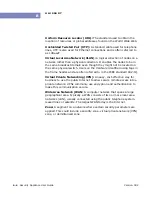
. . . . .
G L O S S A R Y
Version 3R2
Security Appliance User Guide
B-3
Extended Authentication (XAUTH)
: A method to perform user
authentication in a separate phase after the IKE authentication or phase
1 exchange. The authentication name must match the XAUTH
configuration name in order to allow the user to authentication and
permit access.
Firewall:
A hardware device or software application (or a combination of
both) that provides a system that protects a network segment from
unauthorized use, usually from Internet “hackers.” Most firewalls are
installed to protect users from unauthorized Internet access, but can be
deployed to create additional network security.
File Transfer Protocol (FTP):
A protocol used to transfer data over a
network or the Internet. FTP is commonly used to download or upload
files from or to a server.
Gateway:
A special-purpose device often referred to as a router that
transfers IP datagrams from one network to another until they reach
their final destination.
High Availability (HA):
Provides the ability to service end users (i.e.,
sessions) with little or no interruption when failures occur.
Host Name:
A unique name that a host on a network is known as and is
used to identify the host during data transfers.
Hyper Text Transfer Protocol (HTTP):
The protocol that the World
Wide Web uses. HTTP defines how messages are formatted and
transmitted, and what actions Web servers and browsers should take in
response to various commands.
Hub:
A common connection point for multiple devices on a local area
network (LAN) segment. As traffic is sent to a hub port, the hub port
forwards it to all other ports on the hub so all other network devices can
view that traffic.
Internet Control Message Protocol (ICMP):
An extension of IP used
to report packet errors and control or transmit information. Ping is an
example of an ICMP message that is used to test connectivity of a
device.
Internet:
A network that allows millions of computers to be connected
as a single global network. Originally developed by the U. S. Defense
Department, the Internet was designed as a way to prevent
communication breakdown in the event of nuclear war. Today the



























